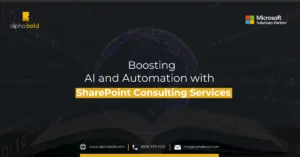Introduction
Let’s start with a question: What if your organization’s information, workflows, and insights could keep pace with business scope? SharePoint has led enterprise collaboration for years, storing files, facilitating teamwork, and driving document management. However, business environments have become more complex, data flows in from countless sources, and the demand for flexibility and responsiveness has never been greater. Integrating SharePoint with Power Platform can help businesses overcome this conundrum.
SharePoint’s role extends beyond content management into a more dynamic and interactive space. This is where the Power Platform steps in—a suite of powerful, low-code tools designed to work seamlessly with SharePoint. With Power Platform, teams can automate processes, build custom applications, and uncover valuable insights from SharePoint data, all with minimal coding required. We’re on the brink of a future driven by a powerful idea: empowering people to achieve more with less friction, fewer bottlenecks, and greater agility. Nearly 90% of C-level leaders rank digital transformation as a top priority, yet 83% of executives continue to face challenges from information silos that hinder collaboration and slow growth.
This post will explore how integrating SharePoint with Power Platform empowers teams, optimizes processes, and helps organizations become more agile, insightful, and resilient in an ever-evolving world.
Power Automate and SharePoint: A Quick Overview
As modern businesses strive to enhance collaboration, automate workflows, and leverage data-driven insights, Microsoft’s Power Platform and SharePoint are the best platforms for driving these transformations. SharePoint, known for its robust document management and collaboration features, has long been known for enterprise content storage and teamwork. However, when integrated with the Power Platform, SharePoint’s capabilities expand beyond traditional functions.
Power Platform, a Microsoft suite of low-code tools, includes Power Apps, Power Automate, and Power BI—applications that allow businesses to automate tasks, build custom apps, and visualize data from SharePoint. Power Automate enables workflow automation to streamline repetitive tasks. Power Apps empowers users to create tailored applications that pull data from SharePoint, and Power BI transforms data into actionable insights through powerful visualizations. These tools enhance SharePoint’s foundational strengths, allowing organizations to build efficient, data-driven, collaborative solutions with minimal coding.
Transforming Business Processes with SharePoint and Power Platform
Let’s look at how integrating SharePoint with Power Platform can alter everyday operations. This section will explore how Power Platform apps like Power Automate, Power Apps, and Power BI work seamlessly with SharePoint to simplify tasks, increase productivity, and unlock new possibilities.
With SharePoint serving as a secure, central repository for information and Power Platform working alongside it, organizations can create apps and workflows that handle repetitive tasks for you. Consider a scenario where an employee submits a project proposal for approval. Instead of manually routing this proposal through multiple layers of email, a Power Automate flow seamlessly takes over: the proposal is sent to the first approver, then routed to the next, and finally documented—all automatically within SharePoint.
Then there is Power Apps. Let’s say a team needs a way to track customer feedback during product launches. With Power Apps, they can build a fully customized feedback app, drawing on SharePoint data, in hours, weeks, or months. This low-code approach makes creating powerful, tailored solutions accessible to anyone.
This goes beyond simple process improvement—it’s true process transformation. When we combine SharePoint with Power Platform, we’re talking about freeing up human potential and empowering people to focus on creative, strategic work rather than getting bogged down by repetitive tasks.
Read more about the Guide for Power Apps Integration with SharePoint.
Empowering Users and Enhancing Productivity
Imagine a workplace where anyone can be a creator, where every team member, not just IT experts—has the tools to build solutions tailored to their needs. This is the power of SharePoint integrated with Power Platform: democratizing innovation and turning every employee into a problem-solver.
With Power Apps, users can build custom applications that pull directly from SharePoint data. Think about this: a salesperson without a line of code can create an app that logs customer interactions or monitors inventory within their team’s SharePoint site. There’s no waiting for IT and no long development cycle. They’ve created a solution that addresses their needs in hours, even minutes. This is the future of productivity, where technology serves the creativity of the user, not the other way around.
And with Power Automate and SharePoint integration, it has become even better. Picture an HR manager who can create an automated workflow for onboarding new hires. With a few clicks, they design a process that schedules training, assigns resources, and notifies the team—all triggered by a single action. That’s real power in the hands of users.
Empowering employees to build solutions on their own terms is more than an efficiency boost. It’s about giving them autonomy to make meaningful changes in their work. When people are enabled to innovate without roadblocks, that’s where productivity soars.
Interested in seeing how SharePoint and Power Platform Integration Can Make a Difference?
SharePoint and Power Platform integration revolutionizes how organizations approach productivity, innovation, and agility. Request a consultation from our SharePoint experts to navigate this journey.
Request a ConsultationData-Driven Decision Making
SharePoint and Power Platform: Future Trends and Innovations
We’re on the edge of an era where technology is evolving so rapidly that today’s tools will seem simple compared to what’s on the horizon.
Let’s start with AI-powered automation. Imagine processes that don’t just execute commands but learn, adapt, and anticipate needs. AI will soon be integrated deeply into Power Platform, allowing users to automate complex workflows and make predictive recommendations. It’s the difference between a system that follows instructions and one that becomes a proactive partner in driving your business forward.
Then, consider the expansion of low-code and no-code platforms. Right now, Power Apps let anyone create an application, but soon, these capabilities will grow exponentially. Soon, business users can design apps with more complex functions, even without coding knowledge. It’s about lowering the barriers to innovation so that the best ideas can be built by those who know the business best.
Security is also evolving, and it’s a big deal. Advanced security and compliance measures will continue to be refined within SharePoint and Power Platform, ensuring data integrity and user privacy. As cyber threats grow, so does the demand for robust security protocols—and Microsoft is investing heavily here, with features like data loss prevention and encrypted access. For executives, this is peace of mind that innovation won’t come at the expense of security.
Finally, we’ll see broader integration capabilities across the Microsoft ecosystem. In the future, SharePoint and Power Platform will connect seamlessly not only within Microsoft 365 but with third-party platforms, allowing businesses to design fully integrated solutions tailored to their unique needs.
This is the future we’re building towards, an adaptive, proactive, and connected workplace. With these tools, companies won’t just keep up with change; they’ll drive it.
Implementation Strategies for SharePoint and Power Platform Integration
1. Start with Governance and Compliance:
2. Training and Support:
3. Collaboration Between IT and Business Units:
4. Roll Out in Phases and Measure Success:
A detailed resource will help you better understand Best Practices for Implementing SharePoint Services.
Equip your Organization with Tools and a Mindset of Continuous Improvement!
With SharePoint as the solid foundation and Power Platform as the versatile toolkit, businesses can streamline workflows, empower users, and drive smarter, data-backed decisions. Let us guide you through this transformation.
Request a ConsultationAlphaBOLD Can Help Drive Transformation with SharePoint and Power Platform
Navigating the integration of SharePoint and Power Platform is no small feat, but AlphaBOLD’s expertise makes the journey seamless and practical. Our team specializes in understanding your organization’s unique needs and designing a tailored approach that maximizes the value of these tools. AlphaBOLD crafts a strategic roadmap that aligns SharePoint and Power Platform with your business goals, ensuring that every solution adds measurable value.
AlphaBOLD is your partner in every transformation phase, from setup and integration to hands-on training and ongoing support. We empower your team to leverage these tools independently, ensuring sustainable success long after implementation. Ready to unlock the full potential of SharePoint and Power Platform? Request a consultation with AlphaBOLD, and let’s build your organization’s future together.
Conclusion
The journey to a more agile, connected, and innovative organization starts with the right tools—and SharePoint integrated with Power Platform offers precisely that. This powerful combination goes beyond traditional productivity software, opening new possibilities to streamline operations, empower teams, and turn data into actionable insights. It’s a shift that lets businesses move faster, make smarter decisions, and drive meaningful changes across every level.
As we look ahead, it’s clear that the future belongs to organizations ready to evolve. By bringing together SharePoint’s stability with Power Platform’s flexibility, companies are equipping themselves to stay resilient and proactive in an ever-changing landscape. Now is the time to rethink how your organization operates, innovate from within, and fully leverage technology to unlock your potential.
Explore Recent Blog Posts








